Nowadays the best ceiling fans will blend in stylishly with your home while keeping your rooms a comfortable temperature. And, despite what you might think, you don’t just have to use the handy cooling gadgets in summer. You can use them all year round even during the winter months to help recirculate warm air around your home. Ceiling fans have come a long way since their introduction in the 1880s. Today, ceiling fans come in an array of styles so you can pick and choose options that will blend in seamlessly with your home.
In our guide to the best ceiling fans, we’ve included a range of designs including traditional-looking fans, a handful with wood finishes and more modern and up to date designs. Investing in a fan is a great option for those who are short on floor space. Unlike the best tower fans, ceiling fans don’t need to take up valuable floor space. You probably won’t even notice them once they are installed on the ceiling.
In addition to the style, when it comes to picking the best ceiling fan for your home it’s important to think about the size of your rooms. If your room is large, you’ll want a large fan to help circulate the air into every nook and crevice. We’d suggest opting for fans sized between 42 and 53 inches. If you have one large room or an open plan living space, you might want to consider a 56-inch fan.
A good ceiling fan does more than just circulate air around your room - some of them double up as lights and a handful of fans that can be installed outdoors, and we’ve included these types below too. For even more ways to cool your space, check out our guide to the best central air conditioning units, or the best portable air conditioners for porting around your home.
1. Hunter Palermo Ceiling Fan: Best ceiling fan overall
Why you can trust Top Ten Reviews
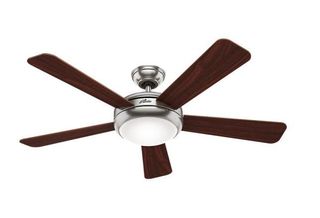
With the Hunter Palermo ceiling fan, you can reverse the motor’s direction for optimal airflow during the summer or winter. This powerful 52-inch fan has a style that straddles the line between modern and traditional, helping it complements most decor. The fan comes with two design options, a brushed nickel finish, where the reversible blades can be either cherry or maple, or a brush bronze finish with black and walnut blades.
If you choose the brushed nickel finish, the reversible blades are cherry on one side and maple on the other. With the brushed bronze finish, the blades have black and walnut sides.
The light fixture on the bottom of the fan uses two 13-watt pin-based compact fluorescent light (CFL) bulbs. These bulbs aren't very bright, according to some user reviews we found, but are sufficient for most rooms. The Hunter Palermo is Energy Star certified, which means it uses less electricity than average ceiling fans, saving money on your energy bill. You can control the fan with the included remote control.
To install this ceiling fan, you need at least seven feet of clearance between the fan and the floor. Since you can't flush-mount the fan, this means it's best in rooms with ceilings around nine feet or higher.
- Read our Hunter Palermo ceiling fan review
2. Fanimation Odyn Ceiling Fan: Best large ceiling fan
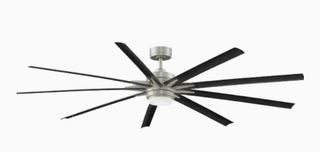
The huge 84-inch span of the Fanimation Odyn uses 32 watts on its highest speed while also moving 11,190 CFM of air, making it the most powerful fan we came across in our research.
The motor on the Fanimation Odyn is quiet and carries a lifetime motor warranty. This ceiling fan is Energy Star certified, and much more efficient than most other fans we evaluated. Its LED lighting system uses less electricity than traditional ceiling fan lights but is just as bright. This fan has nine reversible blades with minimalist styling that come in five finishes.
This fan is very expensive, around $800, and many customer reviews say the quality may not be worth the price, specifically the fan blades, which are made of plastic. With the lighting kit and downrod installed, this fan hangs nearly 18 inches from the ceiling, which means it should be installed on ceilings of 9 feet or higher.
- Read our Fanimation Odyn ceiling fan review
3. Hunter Builder Deluxe 53091: Best affordable ceiling fan
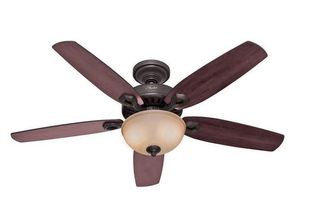
The Hunter 53091 Builder Deluxe works best in rooms between 125 and 250 square feet. You can match this fan to most décors, since it comes in three finishes: brushed nickel, new bronze and white. Each style also has reversible blades with different colors on each side. The three-speed motor has a lifetime warranty and lets you reverse the direction for better performance in summer and winter.
After installation, you can use the included balancing kit to reduce wobbles, which makes the ceiling fan quieter at higher speeds. The fan doesn't include a remote control, so you should mount it low enough to reach the pull chain or purchase a remote separately for around $40.
The fan comes with two 6.5-watt medium base (LED) bulbs in their place.
4. Emerson Luxe Eco: Best ceiling fan for style
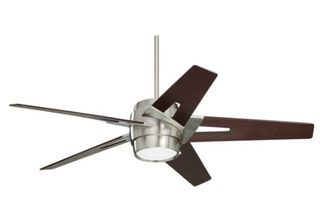
One of the most striking things about the Luxe Eco is the design of the blades, which have small cutouts that you won't see on many ceiling fans. The blades come in dark mahogany or walnut and you also have the choice between brushed steel and oil-rubbed bronze for the motor housing.
The motor has a lifetime warranty, which is comparable to that of most ceiling fans. This fan has an airflow efficiency rating of 210 CFM per watt, making it one of the most efficient fans we looked at.
- Read our Emerson Luxe Eco ceiling fan review
5. Westinghouse Comet Ceiling Fan: Best low profile fan
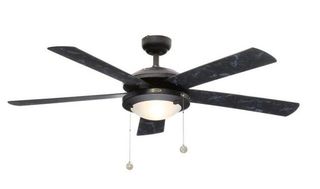
The fan comes with a lifetime motor warranty and a two-year parts warranty. Although lifetime motor warranties aren't uncommon, the parts warranty is better than the one-year average among ceiling fans in our comparison.
The blades come in a matte black finish with a black marble pattern on the reverse side, so you can choose the one that best accentuates your décor. The Comet has a good airflow rating of 3,589 CFM, which is enough for rooms up to 225 square feet. Unfortunately, this fan has an average energy efficiency of 57 CFM per watt, which is lower than the minimum requirements to earn an Energy Star certification.
How much do the best ceiling fans cost?
You can spend as little as $50 or well over $1,000 on a ceiling fan. However, you can expect to spend around $100 to $200 for the most popular models. As with most lighting or HVAC equipment, the cost of a fan generally goes up as its energy efficiency increases.
Premium blade materials, such as machined metal or natural wood, can also make a fan more expensive. There isn't a strong link between a fan's price and its blade size, blade shape, number of blades, airflow rating or motor warranty, which means you can generally choose a design that fits your personal tastes and budget.
The importance of airflow and blade span
Airflow is one of the biggest factors to consider when choosing a ceiling fan. The best fans have an airflow of 3,000 CFM or above. The CFM rating of the fan is the key consideration when choosing a fan, as it determines the area a fan will cool and circulate. The higher the CFM, the bigger area the fan will affect.
It's also important to consider the fan's blade span, because that can affect the fan's airflow and efficiency as fans with longer blades circulate more air and are best in larger rooms. For example, Lumens, an online ceiling fan seller, has a helpful guide on ceiling fan sizes.
What size ceiling fan should you get?
For rooms that are 144 Square Feet, a ceiling fan with a blade span under 42” and a CFM rating of 1,000 - 3,000. For a room between 144 - 225 square feet you should get a ceiling fan that has a 44” to 50” blade span and recommended CFM rating of 1,600 and 4,500.
If you have a room that is between 225 -400 square feet in area, fans with blade spans of over 50” is and a CFM rating of 2,300 and 6,500 is recommended. Anything over 400 square inches needs a 62” blades with a CFM rating of 5,500 to 13,500.
How energy efficient are ceiling fans?
You can use you ceiling fan in conjunction with your air conditioning and heating to save money. Using the two devices in increase the airflow of both hot and cold air and the area covered.
You can also choose an energy-efficient fan for increased savings. The most energy efficient ceiling fans use less than 60 watts on average and have high airflow.
To qualify for Energy Star certification, a fan must produce at least 155 CFM, 100 CFM and 75 CFM of airflow per watt on the high, medium and low speeds respectively.
When planning your energy use, count built-in light fixtures separately, since manufacturers don't combine the fan and lighting wattage.
How long should the motor warranty be?
Because ceiling fans are used long term, their motor warranties should also reflect a long service life, at least 15 years. To earn Certification from Energy Star a motor needs at least 30 years of warranty coverage in addition to excellent energy efficiency.
However, the best protection for a fan’s motor is a lifetime warranty. When it comes to other parts, a one-year warranty is standard among ceiling fan manufacturers. Add-on light kits often have separate warranties.
Ceiling fan mounting options and style
Different ceiling heights may require different fan mounts. If you have a low ceiling, choose a low-profile ceiling fan without a downrod so you don’t bump your head against the fan. Rooms with high or vaulted ceilings often require a downrod kit to lower the fan for better air circulation and access to the controls.
Whether it's modern, traditional, transitional or mid-century, the fan should blend in with the style of your home. For example, polished metal fans with straight blades will likely fit in with modern décor, while traditional homes look best with elegant or rustic ceiling fans that have wood finishes and weathered bronze accents.
Lastly, the number of blades can imbue your space with a certain energy, relaxed or lively, even when the fan's not turning.
Ceiling fan convenience features
The cheapest ceiling fans often lack handheld remotes and dedicated wall controls, so it might be worth choosing a more expensive model for better control. A ceiling fan with a reversible motor lets you optimize the airflow direction for different seasons: counterclockwise during the summer to create a gentle breeze and clockwise during the winter to move heat near the ceiling throughout the room. Choosing a ceiling fan with at least three speed settings allows you to fine-tune it to your comfort level.
Tips for making your ceiling fan more discreet
Ceiling fans have a reputation of being a bit of an eyesore, despite there being many decorative models that can give a room an extra bit of flair. Interior decorators have many tips on how to make a ceiling fan look better.
White ceiling fans are a great way to disguise the fan against a white ceiling. These ceiling fans are usually very discreet, and do very little to disrupt the aesthetic design of a room.
More ceiling fans are also being designed that have retractable blades, or have the fan hidden with a shade.
Best ceiling fans: Pros and cons
- Lower Ambient Temperature: Ceiling Fans can lower the temperature of a room by five degrees. This lower temperature is usually in addition to the other methods in the room, like an AC or open window.
- Keep you Warm: During the summer, ceiling fans work by pushing the air downwards. This creates a disruption in the air, creating a breeze that helps cool down your skin. During the winter, most ceiling fans can be reversed to change the direction of airflow. Because warm air rises, the fan sucks up the cool air, forcing the warm air down.
- Lowers the Bills: The fan both increases the heat and cooling effects in a room. This means you can set you thermostat so it cycles on and off less often, and the work that your furnace and AC won’t have to work as hard.
- Outdoor usage: Ceiling fans can cool outdoor areas, as well as, indoor areas. They are a great way to lower the temperature the porch, patio, decking, in the sunroom, or outdoor kitchen.
- Ambient Light Source: Most ceiling fans come with a built in light, or a light kit to install lights. Some offer a decorative, moody style of lighting. Perfect for cosy nights in front of the television.
Ceiling fans also have many disadvantages
- Low Light Levels: While ceiling fans are great for providing low level mood lighting, if you need a more powerful main light in the room, they are not the ideal ceiling fixtures to have.
- Noisy: Many ceiling fans are designed to produce low levels of noise, and when they are newly installed they generally don’t produce much more than a whisper. But over time the bolts become looser, the blades can shift, and this can produce high levels of noise and squeaks. It takes a lot of maintenance to keep a ceiling fan quiet.
- Pain to clean: The back of the blades tend to be dust magnets, and are hard to keep clean from floor height. This means they need to be cleaned with special poles or vacuum attachments. In some cases you might even need a ladder.
Read more:
Best Tower Fans
Best HEPA Air Filters
Best Portable Coolers
Best Window Air Conditioners
Best In-Wall Air Conditioners
Best Portable Air Conditioners
Best Air Conditioners Overall
Best Central Air Conditioners

